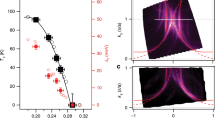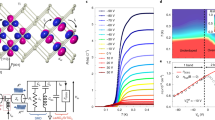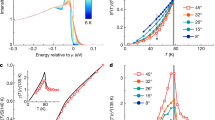Abstract
The fundamental mechanism that gives rise to high-transition-temperature (high-Tc) superconductivity in the copper oxide materials has been debated since the discovery of the phenomenon. Recent work has focused on a sharp ‘kink’ in the kinetic energy spectra of the electrons as a possible signature of the force that creates the superconducting state1,2,3,4,5,6,7,8,9,10,11,12,13,14. The kink has been related to a magnetic resonance13,15,16,17 and also to phonons18. Here we report that infrared spectra of Bi2Sr2CaCu2O8+δ (Bi-2212), shows that this sharp feature can be separated from a broad background and, interestingly, weakens with doping before disappearing completely at a critical doping level of 0.23 holes per copper atom. Superconductivity is still strong in terms of the transition temperature at this doping (Tc ≈ 55 K), so our results rule out both the magnetic resonance peak and phonons as the principal cause of high-Tc superconductivity. The broad background, on the other hand, is a universal property of the copper–oxygen plane and provides a good candidate signature of the ‘glue’ that binds the electrons.
This is a preview of subscription content, access via your institution
Access options
Subscribe to this journal
Receive 51 print issues and online access
$199.00 per year
only $3.90 per issue
Buy this article
- Purchase on Springer Link
- Instant access to full article PDF
Prices may be subject to local taxes which are calculated during checkout



Similar content being viewed by others
References
Rossat-Mignod, J. et al. Neutron scattering study of the YBa2Cu3O6+x system. Physica C 185–189, 86–92 (1991)
Mook, H. A. et al. Spin fluctuations in YBa2Cu3O6.6 . Nature 395, 580–582 (1998)
Fong, H. F. et al. Neutron scattering from magnetic excitations in Bi2Sr2CaCu2O8+δ . Nature 398, 588–591 (1999)
He, H. et al. Resonant spin excitation in an overdoped high temperature superconductor. Phys. Rev. Lett. 86, 1610–1613 (2001)
Kaminski, A. et al. Renormalization of spectral line shape and dispersion below Tc in Bi2Sr2CaCu2O8+δ . Phys. Rev. Lett. 86, 1070–1073 (2001)
Johnson, P. D. et al. Doping and temperature dependence of the mass enhancement observed in the cuprate Bi2Sr2CaCu2O8+δ . Phys. Rev. Lett. 87, 177007 (2001)
Norman, M. R. & Ding, H. Collective modes and the superconducting-state spectral function of Bi2Sr2CaCu2O8+x . Phys. Rev. B 57, R11089–R11092 (1998)
Campuzano, J. C. et al. Electronic spectra and their relation to the (π, π) collective mode in high-Tc superconductors. Phys. Rev. Lett. 83, 3709–3712 (1999)
Abanov, Ar. et al. A relation between the resonance neutron peak and ARPES data in cuprates. Phys. Rev. Lett. 83, 1652–1655 (1999)
Zasadzinski, J. F. et al. Correlation of tunneling spectra in Bi2Sr2CaCu2O8+δ with the resonance spin excitation. Phys. Rev. Lett. 87, 067005 (2001)
Thomas, G. A. et al. Ba2YCu3O7-d: Electrodynamics of crystals with high reflectivity. Phys. Rev. Lett. 61, 1313–1316 (1988)
Puchkov, A. V. et al. Evolution of the pseudogap state of high-Tc superconductors with doping. Phys. Rev. Lett. 77, 3212–3215 (1996)
Carbotte, J. P. et al. Coupling strength of charge carriers to spin fluctuations in high-temperature superconductors. Nature 401, 354–356 (1999)
Munzar, D., Bernhard, C. & Cardona, M. Possible relationship between the peak in magnetic susceptibility and the in-plane far infrared conductivity of YBCO. Physica C 317–318, 547–549 (1999)
Dai, P. et al. Resonance as a measure of pairing correlations in the high-Tc superconductor YBa2Cu3O6.6 . Nature 406, 965–968 (2000)
Demler, E. & Zhang, Z. C. Quantitative test of a microscopic mechanism of high-temperature superconductivity. Nature 396, 733–735 (1998)
Scalapino, D. J. The cuprate pairing mechanism. Science 284, 1282–1283 (1999)
Lanzara, A. et al. Evidence for ubiquitous strong electron-phonon coupling in high-temperature superconductors. Nature 412, 510–514 (2001)
Varma, C. M. et al. Phenomenology of the normal state of Cu-O high-temperature superconductors. Phys. Rev. Lett. 63, 1996–1999 (1989)
Kaminski, A. et al. Quasiparticles in the superconducting state of Bi2Sr2CaCu2O8+δ . Phys. Rev. Lett. 84, 1788–1791 (2000)
Millis, A. J. & Drew, H. D. Quasiparticles in high temperature superconductors: consistency of angle resolved photoemission and optical conductivity. Preprint at 〈http://www.arXiv.org/cond-mat/0303018〉 (2003).
Schachinger, E., Tu, J. J. & Carbotte, J. P. Angle-resolved photoemission spectroscopy and optical renormalizations: phonons or spin fluctuations. Phys. Rev. B 67, 214508 (2003)
Dai, P. et al. The magnetic excitations spectrum and thermodynamics of high-Tc superconductors. Science 284, 1344–1347 (1999)
Hwang, J. et al. Marginal Fermi liquid analysis of 300 K reflectance of Bi2Sr2CaCu2O8+δ. Preprint at 〈http://www.arXiv.org/cond-mat/0306250〉 (2003).
Chakravarty, S. et al. Hidden order in the cuprates. Phys. Rev. B 63, 094503 (2001)
Loram, J. W. et al. The condensation energy and pseudogap energy scale of Bi:2212 from electronic specific heat. Physica C 341–348, 831–834 (2000)
Shibauchi, T. et al. Closing the pseudogap by Zeeman splitting in Bi2Sr2CaCu2O8+y at high magnetic fields. Phys. Rev. Lett. 86, 5763–5766 (2001)
Takenaka, K., Mizuhashi, K., Takagi, H. & Uchida, S. Interplane charge transport in YBa2Cu3O7–y: Spin gap effect on in-plane and out-of-plane resistivity. Phys. Rev. B 50, 6534–6537 (1994)
Homes, C. C. et al. Technique for measuring the reflectance of irregular, submillimeter-sized samples. Appl. Opt. 32, 2976–2983 (1993)
Eisaki, H. et al. Effect of chemical inhomogeneity in the bismuth-based copper oxide superconductors. Phys. Rev. B (in the press); preprint at 〈http://www.arXiv.org/cond-mat/0312429〉 (2004)
Acknowledgements
This work has been supported by the Canadian Natural Science and Engineering Research Council and the Canadian Institute of Advanced Research. We thank H. Eisaki and M. Greven for supplying us with several crystals. Their work at Stanford University was supported by the Department of Energy's Office of Basic Sciences, Division of Materials Science. The work at Brookhaven was supported in part by the Department of Energy. We thank D. N. Basov, J. P. Carbotte, G. M. Luke and M. R. Norman for discussions.
Author information
Authors and Affiliations
Corresponding author
Ethics declarations
Competing interests
The authors declare that they have no competing financial interests.
Rights and permissions
About this article
Cite this article
Hwang, J., Timusk, T. & Gu, G. High-transition-temperature superconductivity in the absence of the magnetic-resonance mode. Nature 427, 714–717 (2004). https://doi.org/10.1038/nature02347
Received:
Accepted:
Issue Date:
DOI: https://doi.org/10.1038/nature02347
This article is cited by
-
Fermi liquid-like behaviour of cuprates in the pseudogap phase simulated via T-dependent electron-boson spectral density
Scientific Reports (2023)
-
Property alteration of (Bi,Pb)-2212 superconductors added with graphene oxide nanoparticles
Journal of Materials Science: Materials in Electronics (2023)
-
Investigation of Physical Properties of (Nano-SmIG)/(Bi, Pb)-2212 Phase
Journal of Low Temperature Physics (2023)
-
Doping-dependent superconducting physical quantities of K-doped BaFe\(_2\)As\(_2\) obtained through infrared spectroscopy
Scientific Reports (2022)
-
Enhanced cathodic activity by tantalum inclusion at B-site of La0.6Sr0.4CO0.4Fe0.6O3 based on structural property tailored via camphor-assisted solid-state reaction
Journal of Advanced Ceramics (2022)
Comments
By submitting a comment you agree to abide by our Terms and Community Guidelines. If you find something abusive or that does not comply with our terms or guidelines please flag it as inappropriate.



